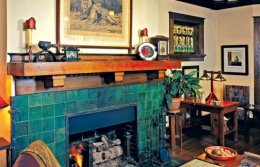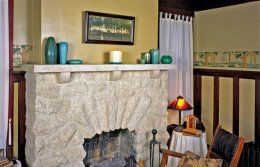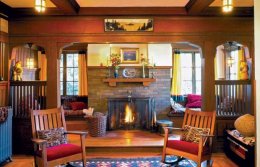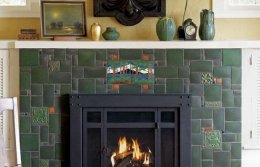
 Stunning green tile accented by riveted iron straps makes the hearth the centerpiece associated with space within Memphis bungalow. It’s unbelievable a previous owner had painted the whole thing red. (Picture: Linda Svendsen)
Stunning green tile accented by riveted iron straps makes the hearth the centerpiece associated with space within Memphis bungalow. It’s unbelievable a previous owner had painted the whole thing red. (Picture: Linda Svendsen)
Fire fulfills a deep and primal part when you look at the individual psyche. Even today, when fires are not any longer required for heating or cooking, fireplaces tend to be consistently installed in homes. In Arts & Crafts homes, the hearth took on practically religious relevance, as well as bungalows in warm climates had been constructed with one. Gustav Stickley ended up being a huge proponent, writing in The Craftsman, “The big hospitable hearth is virtually absolutely essential, the hearthstone is almost always the center of true house life.”
Almost always an attribute regarding the living room, fireplaces additionally had been found in dining rooms, bed rooms, dens, and basements. Regularly the fireplace had been in the middle of integrated benches or settles to create an inglenook, which had a lowered roof that provided a feeling of coziness and set it faraway from other area. With or without an inglenook, the hearth usually ended up being in the middle of some type of built-ins—often glass-door bookcases with a high windows above, but a drop-front desk using one part had been relatively typical as well.
Bricks and much more
a curved limestone fireplace an additional Memphis bungalow features a hearth of Rookwood tiles. The firebox is home to a couple of 1930s classic gasoline logs. (Picture: Linda Svendsen)
 Chimneys were of masonry construction (stone, stone, concrete block), nevertheless hearth itself could possibly be faced with a wide array of materials, including brick, rock, porcelain tile, cast stone, concrete, stucco, material, or plaster—anything that willn’t burn off. Brick had been a great deal favored, specially clinker bricks, those that had become vitrified and misshapen by sitting too near to the fire within the brick kiln. Ahead of the bungalow age, clinker bricks were disposed of, making them cheap and/or no-cost, which undoubtedly made the eyes of several a speculative bungalow builder illuminate. Because clinkers were organic and interesting to consider, the movement embraced all of them, and very quickly they truly became fashionable. A number of other forms of brick were used also, from basic red or gold bricks, to wire-cut (textured) bricks, to bricks that have been multicolored or spotted, and even attractive shaped bricks.
Chimneys were of masonry construction (stone, stone, concrete block), nevertheless hearth itself could possibly be faced with a wide array of materials, including brick, rock, porcelain tile, cast stone, concrete, stucco, material, or plaster—anything that willn’t burn off. Brick had been a great deal favored, specially clinker bricks, those that had become vitrified and misshapen by sitting too near to the fire within the brick kiln. Ahead of the bungalow age, clinker bricks were disposed of, making them cheap and/or no-cost, which undoubtedly made the eyes of several a speculative bungalow builder illuminate. Because clinkers were organic and interesting to consider, the movement embraced all of them, and very quickly they truly became fashionable. A number of other forms of brick were used also, from basic red or gold bricks, to wire-cut (textured) bricks, to bricks that have been multicolored or spotted, and even attractive shaped bricks.
Brick sizes have already been standardised for centuries at 2¼" x 3¾" x 8". They come in many colors and textures, and there are numerous methods for laying them, called bonds. Most people are acquainted operating bond, in which joints in each line tend to be staggered by half a brick. Flemish bond features one brick switched on end every other stone. Multicolored brick habits had been known as tapestry brick. Brick in addition might be set unevenly and arbitrarily, generally eccentric brickwork. In Craftsman homes, brickwork was sometimes combined with lake stones to make what's usually called peanut brittle, due to the lumpy look. Periodically some usage had been manufactured from glazed bricks, that have been completed like pottery.
 Set down by a spindled colonnade, this stone hearth is in the middle of a generously sized inglenook with cushioned benches. (Photo: Douglas Keister)
Set down by a spindled colonnade, this stone hearth is in the middle of a generously sized inglenook with cushioned benches. (Photo: Douglas Keister)
Rock, including fieldstone, lake rock, cobblestone, or rubble rock, had the austere appearance esteemed by bungalow designers. Split-face ashlar (rectangular cut stone with an irregular face), though a little more formal, also was applied to fireplaces. Cast stone, a molded product created from tangible and good aggregates, usually ended up being utilized in host to real rock. It may look like whatever type of stone ended up being required, although sandstone and limestone had been many widespread. Pushed cement had been another option, molded into panels about 1½" dense, and large enough to represent the complete front side for the hearth. They were shaped and colored to look like tile or rock, and often genuine tiles were inset as accents.
Green Motawi field tiles tend to be combined with landscape alongside ornamental tiles in a seemingly arbitrary layout with this fireplace.
Porcelain tile has also been much in favor as a fireplace facing, from ordinary 6" x 6" field tiles to decorative art tiles from now-famous Arts & Crafts potteries like Grueby, Rookwood, and Batchelder. Numerous fireplaces combined decorative accent tiles and area tiles, with accents set in to the center over the firebox, in corners, or along the sides. Landscape tiles were particularly favored, with views of medieval castles, Spanish missions, and English villages. Many businesses also could provide matching porcelain corbels (to put on within the mantel), keystones (for arched fireboxes), and different trim tiles. It had been possible to purchase your whole hearth front side through the same organization therefore the firebox might be built to match the tiles rather than the various other way around.












